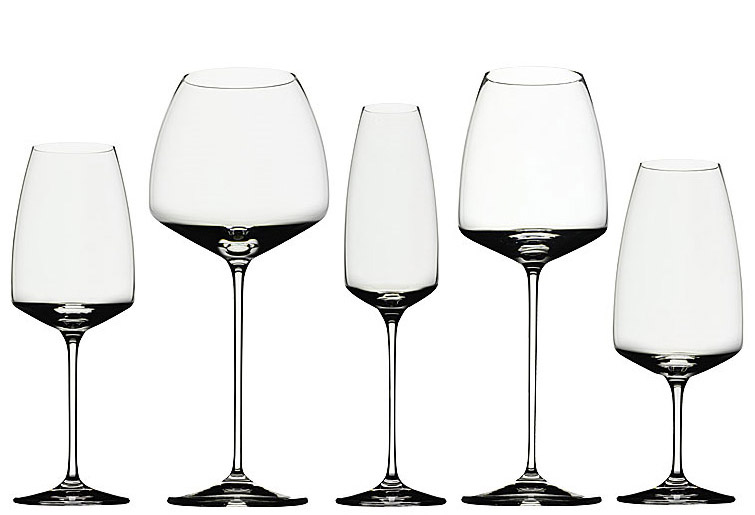Before you spend a zillion dollars on wine glasses there’s something you need to know:
Modern stemware is the equivalent of a pushup bra. Well, nothing wrong with that. Few of us, when faced with the bare truth, are so disenchanted we turn away in horror and switch on Leno instead.
I think Riedel’s insight – to design a bowl for every style of wine – was a stroke of design genius that deserves to be in MOMA. Riedel literally revolutionized the stemware business. (Thus becoming the Victoria’s Secret of stemware.)

Having said that, you need to pay at least as much attention to how you live, entertain and drink as to your need for the proper wine glass. My sister gave us a couple of champagne flutes that look beautiful, but I’m a klutz – the stems are so tall I distrust their centre of gravity.
Do you spend your life in fear of the environment poisoning you? Lead was originally added to crystal for clarity. (Lead oxide is white.) It also made glass tougher, lending crystal a rubbery consistency.
Thirty years ago, a scientist with too much time on his hands measured the lead content of his Glen Skunky stored in a crystal decanter. He was horrified to discover lead had leached into his booze.

Although the likelihood of lead dissolving into your wine after less than an hour in the glass is pretty much nil, if you’re one of those folks who worry about this stuff you want to avoid leaded crystal. (Actually you should avoid drinking red wine altogether as it’s loaded with minerals.) Of more interest is that the replacements for lead give the glass different mechanical properties.
Eisch has patented an oxygen-permeable glass. Mikasa, Orrefors, Boda, and every other traditional crystal maker produce gorgeous looking glasses available in traditional bowls and in knock-offs of the Riedel shapes using various materials including – in some jurisdictions – lead.
The bowl variety creates a very practical issue, above and beyond what it adds to or subtracts from your drinking pleasure. How do you clean the damn things?
I have friends in Australia who only hand wash the morning after, as I did until I ascended into the class of Dishwasher Owners. Washing wasn’t the only source of trouble. I remember a particular evening a long time ago, when a friend attempted to juggle three Rosenthal snifters. Since then I’ve broken literally dozens of stems.
Schott Zwiesel stems are tougher than most – they’ve replaced lead with titanium and zirconium oxide – and if I were still running my swinging bachelor pad this would might be a deal maker.
Dishwashers are less punitive on stems than I am, although we had one dishwasher that ate crystal like a carnie. (We ended up with Mexican stems made from recycled glass.) I find some stems are impossible for me to hand wash. The above mentioned Schott Zwiesel in particular has such small openings I can’t get my fingers inside the bowl.
But back to taste and the perfect stem: Riedel’s insight was to shape the bowl to land the wine on the appropriate part of the tongue for the wine in question. They also shorten or lengthen the bowl, choking or opening the chimney to attenuate the bouquet.
But – and this butt is of Sir Mix-A-Lot dimensions – Riedel is designing their bowls to provide specific flavours.
I had an argument with Max Riedel about his bourbon glass and his vintage port glass, neither of which provided me with the expected taste spectrum. He agreed with me about the bourbon – the design parameter was set by Jim Beam – but he politely told me to soak my head and try the port glass again.

Not only do the glasses provide specific taste profiles, they are designed and most often utilized in particular conditions. What about humidity? Napa, Barossa, and Southern Ontario humidity is about twice that of Saskatoon’s. Bouquet travels a whole lot further in those tasting rooms than in a Red Deer dining room.
For these reasons I sometimes disagree with the “official” wine glass. Heck, I’ll skip the falsies and prosthetics and go with the natural look; for years the official wine glass of Tuscan trattorias was a plexi tumbler that looks identical to your grandmother’s tooth glass.
If you worry what wine snob friends think of your choice of glass, you probably should stick with Riedel. (And they have another brilliant design, the O series, that has the same bowl shape but no stems, easing dishwasher use.)
I like Eisch for big reds, Riedel for whites, and sundry crystal manufacturers for the rest. Our martini glasses are Mikasa and I am willing to drink water in them just for the pleasure of looking at them.

All of these shapes and manufacturers are readily available in most cities and bigger towns, and of course over the Internet. Of more interest is the knock-offs, which are copying the bowl shapes in basic glass and cheap crystal.
Which choice is right for you? Depends on budget and sensibility. In my swinging bachelor pad days, I drank from crystal snifters – they’re big enough to hold a beer and did a pretty good job with wine, and worked just fine with cognac and scotch. And their low centre of gravity reduces the probability of spills.

If I were setting up a student pad today, I’d probably buy some Riedel O series, or maybe a knock-off and be done with it. (Alternatively, were I really broke I’d probably pick up the unbreakable and recycleable Govino in two bowl shapes.) People like me who think you ought to drink wine from crystal will want not just good crystal, but a selection of bowl shapes to suit different wines.
The choice is yours.
___
James Romanow writes about wine and all things boozy for the Spectator Tribune. Follow him @drbooze
Follow us: @SpectatorTrib
